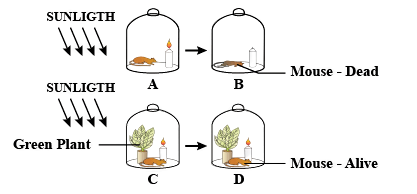
The diagrams given below represent the relationship between a mouse and a physiological process that occurs in green plants. Study the diagrams and answer the questions that follow: Name the physiological process occurring in the green plant that has kept the mouse alive.


Answer
555.6k+ views
Hint: All living things require oxygen to survive. Oxygen is useful in growth, reproduction, and the conversion of food into energy. Humans breathe oxygen through their nose and mouth into their lungs. Plants release oxygen and intake of carbon dioxide.
Complete answer: Photosynthesis is a biological process that takes place in the green plant. This process of keeping the mouse alive in the above diagram. Photosynthesis is the physiological process of living plant cells. Plant cells contain chlorophyll to produce their food in the form of substances like glucose and starch using carbon dioxide, water, and light energy (mainly sunlight). Plants release oxygen into their surroundings during this process. Oxygen being a life supporter for the living organisms on the earth’s surface, is keeping the mouse alive. In the bell jar B, the green plant is absent therefore there is no oxygen by the photosynthesis process in jar B. The oxygen left in the jar upon closing has already been consumed by the burning candle and the mouse. As a result of lack of oxygen, the mouse died in jar B and the candle also got extinguished. The importance of the process of photosynthesis is that it is the only biological and physiological process that releases oxygen into the atmosphere which supports all life forms on the earth.
Additional Information:
Plants and algae contain organelles known as chloroplasts where the process of photosynthesis takes place. A normal plant cell has about 10 to 100 chloroplasts which are enclosed by a membrane. The membrane contains an aqueous fluid known as the stroma. Stroma is the stacks of thylakoids which make the grana the site of photosynthesis.
Note: The very first photosynthetic organisms used reducing agents like hydrogen or hydrogen sulphide. They evolved early in the evolutionary history of life. The cyanobacteria came into existence later and produced oxygen by the process of photosynthesis. The excess oxygen produced by them contributed to the oxygenation of the Earth directly. This made the evolution of higher life possible.
Complete answer: Photosynthesis is a biological process that takes place in the green plant. This process of keeping the mouse alive in the above diagram. Photosynthesis is the physiological process of living plant cells. Plant cells contain chlorophyll to produce their food in the form of substances like glucose and starch using carbon dioxide, water, and light energy (mainly sunlight). Plants release oxygen into their surroundings during this process. Oxygen being a life supporter for the living organisms on the earth’s surface, is keeping the mouse alive. In the bell jar B, the green plant is absent therefore there is no oxygen by the photosynthesis process in jar B. The oxygen left in the jar upon closing has already been consumed by the burning candle and the mouse. As a result of lack of oxygen, the mouse died in jar B and the candle also got extinguished. The importance of the process of photosynthesis is that it is the only biological and physiological process that releases oxygen into the atmosphere which supports all life forms on the earth.
Additional Information:
Plants and algae contain organelles known as chloroplasts where the process of photosynthesis takes place. A normal plant cell has about 10 to 100 chloroplasts which are enclosed by a membrane. The membrane contains an aqueous fluid known as the stroma. Stroma is the stacks of thylakoids which make the grana the site of photosynthesis.
Note: The very first photosynthetic organisms used reducing agents like hydrogen or hydrogen sulphide. They evolved early in the evolutionary history of life. The cyanobacteria came into existence later and produced oxygen by the process of photosynthesis. The excess oxygen produced by them contributed to the oxygenation of the Earth directly. This made the evolution of higher life possible.
Recently Updated Pages
Master Class 11 Economics: Engaging Questions & Answers for Success

Master Class 11 English: Engaging Questions & Answers for Success

Master Class 11 Social Science: Engaging Questions & Answers for Success

Master Class 11 Biology: Engaging Questions & Answers for Success

Class 11 Question and Answer - Your Ultimate Solutions Guide

Master Class 11 Business Studies: Engaging Questions & Answers for Success

Trending doubts
What is meant by exothermic and endothermic reactions class 11 chemistry CBSE

10 examples of friction in our daily life

One Metric ton is equal to kg A 10000 B 1000 C 100 class 11 physics CBSE

Difference Between Prokaryotic Cells and Eukaryotic Cells

What are Quantum numbers Explain the quantum number class 11 chemistry CBSE

1 Quintal is equal to a 110 kg b 10 kg c 100kg d 1000 class 11 physics CBSE




